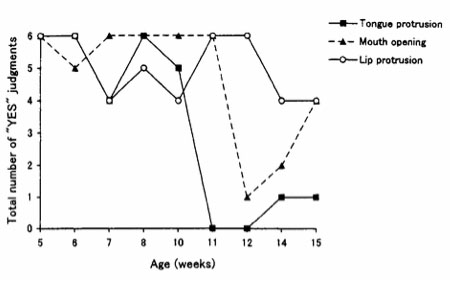Imitation in Primates
Biology 342 Fall 2014
Annelise Hill Yasemin Lopez
Ontogeny
Development of Neonatal Imitation
Neonatal (newborn) imitation (particularly lip-smacking) in rhesus macaques has been shown to develop within the first few days of life. Humans have also been shown to imitate a range of acts within their first year of life. Similar neonatal imitation studies have been done in chimpanzees. One study found that imitative responses disappeared after 9 weeks of age. The figure below shows this phenomenon, with frequency (total number of recorded "yes" judgements) of tongue protrusion, mouth opening, and lip protrusion decreasing as the individual chimpanzee gets older. (Myowa-Yamakoshi 2001)
Environmental Impact on Imitation Behavior
All cited studies and experiments were done in labs, and while it's not known exactly how conditions would be in the wild, it’s possible that the lab conditions affected the imitation behavior that the subjects showed. For example, one study (Ferrari et al.) found that rhesus macaque infants only matched a limited number of gestures and only for a limited time course (Ferrari et al.). The authors hypothesized that this behavior development could be attributed to the environmental rearing conditions, unnatural sources of stimuli, and the fact that the infants were separated from their mothers at birth.

Figure 3. Developmental changes in the total number of "yes" judgements. (Myowa-Yamakoshi, M. 2001)